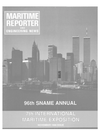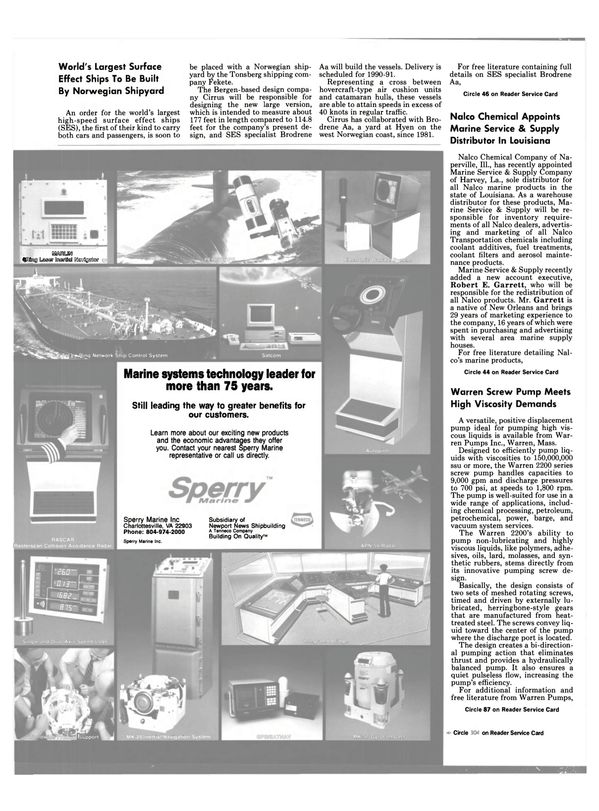
Exxon Offers Exxcare— A Cost-Cutting Computerized Solution To Maintaining/Monitoring Oil
—Technical Paper Available— Good lubrication contributes greatly to the efficient operation and long service life of machinery.
In turn, good lubrication depends on two factors, i.e.—a proper selection of products and a sound care of the lubricants in service, which really means keeping any lubricant contamination that will occur during service to a minimum. To implement such care, it is necessary to have reliable monitoring of oil condition coupled with an effective system for maintaining the quality of the oil at the required level.
Exxon Company International's solution to monitoring and maintaining oil condition is Exxcare®, a programmed analysis system for efficient maintenance of Exxon lubricants in service, whether in diesel engines or in other machinery.
At first glance, Exxcare appears to be similar to other systems used for fast analysis of oils in service.
Exxcare, like other systems, uses a Sampling Kit containing small plastic sample bottles, which can be air mailed to specialized laboratories for quick analysis. The Sampling Kit, of course, contains other related material to make the sampling and mailing operation both smooth and simple. Even at this first and simplest stage of the Exxcare system, special attention has been paid to provide the ship's engineer with specific advice on sampling techniques aimed at ensuring that a representative sample is taken at all times.
However, what really singles out Exxcare is its computerized expert system designed to perform a comprehensive analysis of all test results obtained and translate that analysis in specific operational advice relevant to the situation under study.
Exxcare is primarily intended for main propulsion system oils in circulation.
It can, however, also provide routine analysis of other large capacity installations and practically the entire range of machinery and systems on board ship. Since not all the tests performed within Exxcare are relevant to all situations, the number of tests to be carried out has been tailored to actual requirements and varies according to "testing programs," which link the type of product to its application. Of course, non-routine samples mailed by the ship personnel with a specific request for prompt analysis on account of a stated emergency condition will be accommodated.
Tests are performed according to well-established procedures, supplemented by special analytical techniques such as gas chromatography, emissions spectroscopy and others, as might be required.
The tests are categorized as: Basic— tests that are always performed as a matter of course, in conformity with the "testing programs"; Supplementary—tests that are run anytime the results of Basic tests warrant a wider investigation; and Optional—tests that are performed if an operator specifically requires them.
On completion of testing related to a certain program, the computer carries out the trend analysis on the tests' results. This comprises: (1) Comparing each quality characteristic of the oil in service against industry specified limits and when these are not stated, against desirable levels developed by Exxon through well-established field experience.
(2)Assessing the magnitude of change between consecutive analyses.
This is a particularly useful indicator of type and urgency of corrective actions required for characteristics such as viscosity and Total Base Number (TBN).
(3) Analyzing the possibility of interdependence of significant changes of quality features such as viscosity and insolubles content, TBN and water content, flash point and fuel contamination.
The computerized expert system of Exxcare reliably analyzes causeeffect relationships through a network of critical paths in the computer evaluation of test results. This network leads to a range of key situations, each representing the outcome of laboratory and computer analysis, inclusive of specific advice for appropriate remedial actions.
With the use of Exxcare, an overall trend analysis can be established based on an analytical history and the rate of change of physico-chemical characteristics of a lubricant in the recent past.
The overall condition of a system oil can only be assessed through a combination of tests, the analysis of which is seldom easy and may be quite time consuming. The use of an Exxcare computerized expert system takes this chore away from the operator while at the same time offering him a reliable in-depth analysis, with the added bonus of consistency of diagnostic approach and advice as opposed to individual interpretations. The Exxcare trend analysis program covers 125 situations, large enough to cater to most, if not all, eventualities.
The importance of lubricant care from the standpoint of efficiency and safety of machinery operation cannot be overemphasized. A computerized expert system, such as that available through Exxcare, appears to offer the best chance of a reliable and consistent trend analysis, thus optimizing maintenance of lubricants in service. Of course, good purifying and handling practices on board ship remain an operational must.
Exxon Company International is offering a free technical paper detailing the Exxcare computerized expert system. The paper will be available at the Exxon display, Booth 324, at the 7th International Maritime Exposition of the Society of Naval Architects and Marine Engineers (SNAME) Annual Meeting in the New York Hilton, New York City on November 9-12. Additionally, the technical paper can be obtained by writing to: Robert E.
Berner, Exxon Company International, 222 Park Avenue, Florham Park, N.J. 07932-1002.
For a free brochure on Exxcare, C i r c l e 1 1 o n Reader Service Card
Read Exxon Offers Exxcare— A Cost-Cutting Computerized Solution To Maintaining/Monitoring Oil in Pdf, Flash or Html5 edition of November 1988 Maritime Reporter
Other stories from November 1988 issue
Content
- Program For U.S. Shipyard Revitalization Proposed page: 5
- $135-Million Luxury Cruise Vessel Ordered From Wartsila Marine By Finnish Shipowner Birka Line page: 6
- Newport News Announces Management Restructuring page: 7
- Moss Point Marine Completes Four-Ship U.S. Army Contract page: 8
- Joint Venture Formed To Build, Operate Passenger Submarines page: 8
- Anders Wilhelmsen Buys Royal Admiral page: 9
- Gladding-Hearn, LQMoffitt Develop Bearing Flange Design Solution page: 9
- Shrimper/Crabber Built By Mid-Coast Marine page: 10
- Omnithruster Waterjets Offer Maneuverability In Polar Regions page: 11
- World Orderbook Highest In Two Years page: 14
- Westmont Receives $24-Million Contract For Five Floating Cranes page: 14
- Colonna's Shipyard Elects Owen VP And GM page: 14
- Bender Delivers Two Factory Ships—Receives Contracts For Two More page: 15
- MMC International Announces New Tape And Valve Catalog page: 15
- Cargo Ship To Undergo $19.8-Million Conversion At Bay Shipbuilding page: 15
- McDermott International Forms Executive Operating Committee page: 16
- Nichols Bros. Wins $8-Million Contract To Build Six Ferries page: 16
- Non-Ferrous Offers Free Literature On Full Range Of Fasteners page: 17
- Falk Brochure Details Concentric Shaft Reducers page: 17
- SNAME 95th Annual Meeting and 7th International Maritime Exposition page: 20
- Mobile Telesystems Begins Operations page: 46
- New 42-Page Catalog On Flanged Ball Valve From Jamesbury page: 46
- Exxon Offers Exxcare— A Cost-Cutting Computerized Solution To Maintaining/Monitoring Oil page: 48
- Crandall Railway System Again Proves Its Versatility/Dependability page: 49
- Marine Travelift Brochure Describes Benefits Of BFM Mobile Boat Hoist Design page: 49
- Warren Screw Pump Meets High Viscosity Demands page: 50
- Nalfleet, Bull And Roberts Introduces New Approach To Water Treatment page: 52
- SPD Technologies Expands Through New Acquisitions And Product Development page: 56
- CALS Conference Slated For December 8 At USMMA-Kings Point page: 58
- Free Butterworth Brochure Details Types K/Super K Tank Cleaning Machines page: 58
- TBT-Containing Antifouling Paints —The Legislative Position— page: 59
- AT LAST, A GOVERNMENT PROGRAM THAT CAN BENEFIT ALL Implication of CALS to Industry page: 60
- OUTSTANDING WORKBOATS OF 1988 page: 62
- MAN B&W Engines Continue To Make Impact page: 71
- Gladding-Hearn Announces Sale Of Its Fourth INCAT To New York City Ferry Service page: 72
- Volvo Penta Engines Stipulated For Each Of Two 'Hybrid' Ships page: 72
- Port Of Iberia Acquires 70 Adjoining Acres In Master Development Plan page: 73
- Employee Buyout Helps Seattle Yard Emerge From Bankruptcy page: 74
- Hempel's Reports Good Response To New Cargo Barriers Coatings page: 74
- Stauff-Test Pressure Check System Developed By Stauff Corporation page: 75
- Safety Lifting Clamps For Plate And Structural Steel Featured In New Brochure page: 76
- Kiene Diesel Accessories' New Injector Puller Saves Time And Money page: 77
- New ARQ Radio Telex Station Offered By Hull page: 78
- Schroder Offers Six-Pcige Color Brochure On Marine Propulsion Control Systems page: 78
- Krupp MaK Wins $21.6-Million Retrofit Contract For Canadian Icebreaker page: 79
- Navy Approves PPG Coating To Stop Cable Fires page: 79
- Modern Cargo Pumps For Tankers And Barges page: 80
- Furuno Introduces High-Power FR-1500D Series Radar page: 82
- Acurex Introduces 'AutoNet'—Its Latest Portable Software System page: 82
- 75-Page Book On How To Survive Abandoning Ship Offered By Viking page: 83
- Tidewater Marine Adds Five M a r A d Vessels To Worldwide Fleet page: 84
- MAN B&W Diesel Introduces Two More Large Bore Engines page: 85
- Cospolich Develops Refrigerators With Extraordinary Capability page: 86
- New Rules To Mandate Sealing Of Barges page: 87
- Brochures From Hagglunds Describe Computerized Cargo Handling Systems page: 89
- Nichols To Build Advanced Technology 'Wave Piercer' For Fast Passenger Service page: 90
- Custom, Design-lt-Yourself Continuous Liquid Level Indicators Introduced By Gems page: 90
- Complicated RO/RO Conversions Completed By Danyard A /S page: 91
- B&W To Build 84,000-Dwt Products Carrier page: 91
- Bird-Johnson Names Vaughn Seattle Operation's Marketing And Sales Manager page: 93
- Harris SSB Radio Has Noise Blanker page: 94
- Sulzer-Powered French Containership Is Designed For Minimum Crewing page: 94
- Advanced Fiber Technology From Allied-Signal Division Improves Marine Rope Performance page: 99
- 'Space-Age' Simulator Program At MarineSafety Prepares Officers To Handle Super Containerships page: 106
- Munson Introduces Fast, Low-Wake Boat Designed For Harbor Commuter Routes page: 106
- AESA To Build Three More Reefers For Del Monte page: 107


